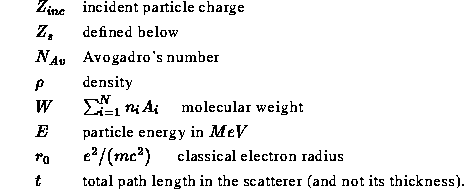In formula (![]() ) above c
the critical
scattering angle defined as:
c2= {4 πe4ZsρNAvZinc2t
) above c
the critical
scattering angle defined as:
c2= {4 πe4ZsρNAvZinc2t
with

The variable c is factorised into two parts. The first part, cc , is a constant of the medium for a given incident particle. The second part depends on the incident particle energy and on the path length in the medium.
cc2= {4 πe4ZsρNAv
The variable CHC or CHCMOL stored in Q(JPROB+25) corresponds to cc . B is defined by the equation 0,
where 0 can be interpreted as the number of collisions in the step:
0={ χc2
Here is Euler's constant ( ) and α the atomic electron screening angle. For a single element this is given by:
α2= ( {λ0
where
| 0 |
| |
| TF | 0Z-{1
| |
| 0 | 2
| |
|
|
so that we have
α2= {m2e41.13
For a compound/mixture the following rule holds:
| α2) | i=1NniZi(Zi+1) ln( χαi2)
| |
| i=1N{pi
| ||
| 2e41.13
| ||
| i=1N{pi
|
To understand the transformations in the above formulae, the following should be noted. Let i be the number of atoms of type i in a compound/mixture, that is the number of moles of element i in a mole of material, and i the proportion by weight of that element. We have the following relation:
i= {niAi
so that we can simplify expressions in the following way:
i=1Nni...
If now we set
| s | i = 1NniZi(Zi+1) | i = 1N{pi | s'
| |||
| E | i = 1NniZi(Zi+ 1 )lnZi-2/3 | i | E'
| |||
| x | i = 1NniZi(Zi+ 1 ) ln[ 1+3.34( {αZiZinc
| |||||
| i = 1N{pi | x'
|
we can write:
| α2) | 2e41.13
| |
| α2 | 2e41.13
|
and finally:
| 0 | c2
| |
| 4ZsρNAvZinc2t
| ||
| cZinc2{t
| ||
| c | Av2
|
The quantity c is calculated during initialisation by the routine GMOLI setting and inc=1 . This variable is called OMC or OMCMOL and it is stored in Q(JPROB+21). It has, via the atomic electron screening angle α2 , a small dependence on and inc in the term x . The quantity cρZs'
is re-evaluated during tracking by the routine GMOLIO, called by GMULTS, only when necessary.
The dependence of x on and inc is via a term of the form: incβ-1)2 , so it is not necessary to recalculate it as long as incβ-1)2≈1 + 3.34(αZ )2 that is:
| 2[ ( {Zinc | 2{Zinc2- β2 | -2≈5500
| ||||
| 2( Zinc2- β2) | 2
|
For mixtures/compounds this condition should be checked for every component and this would be unacceptable from the point of view of computer time. So we simply make the condition more restrictive multiplying the first term by the number of elements in the mixture/compound.